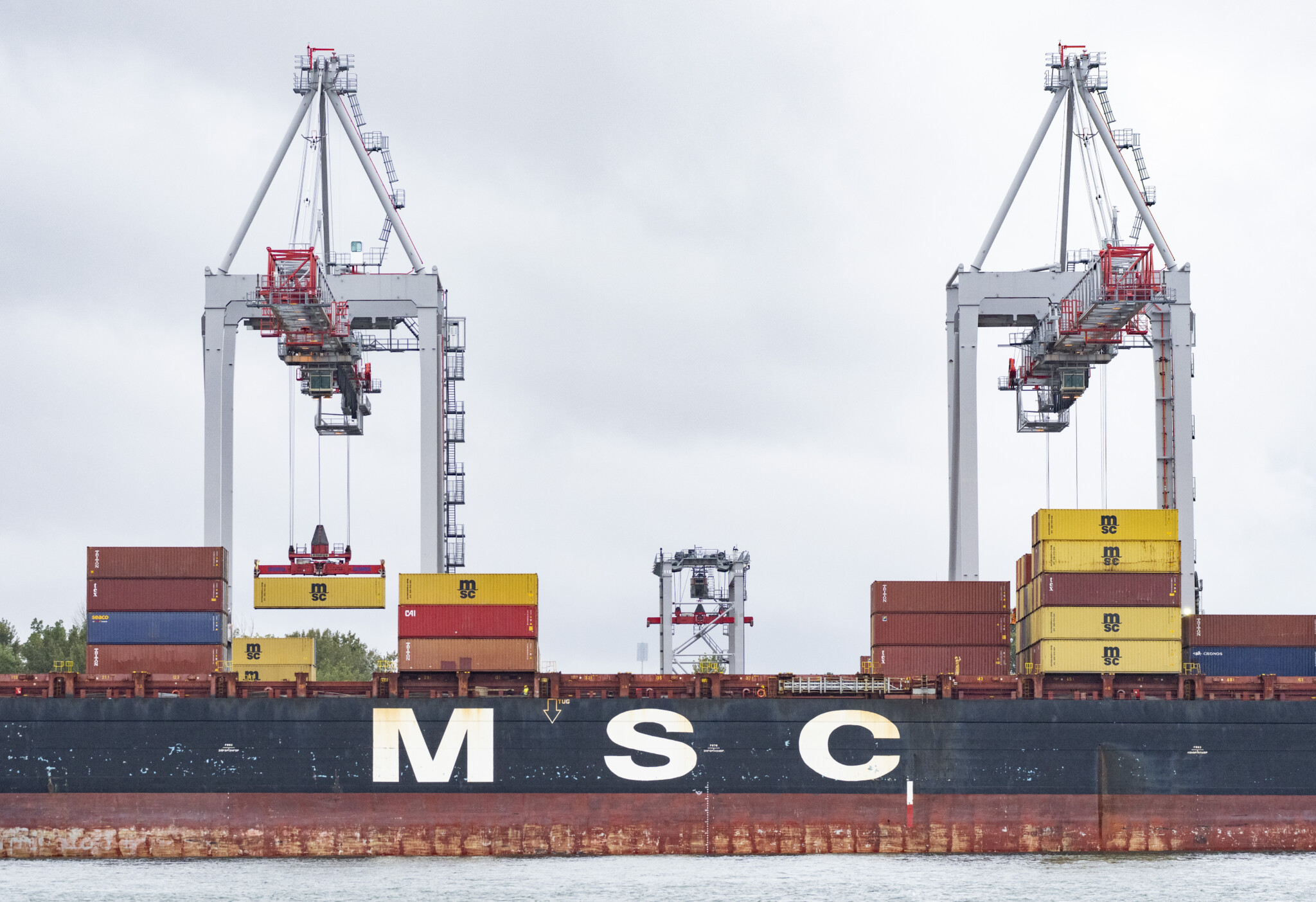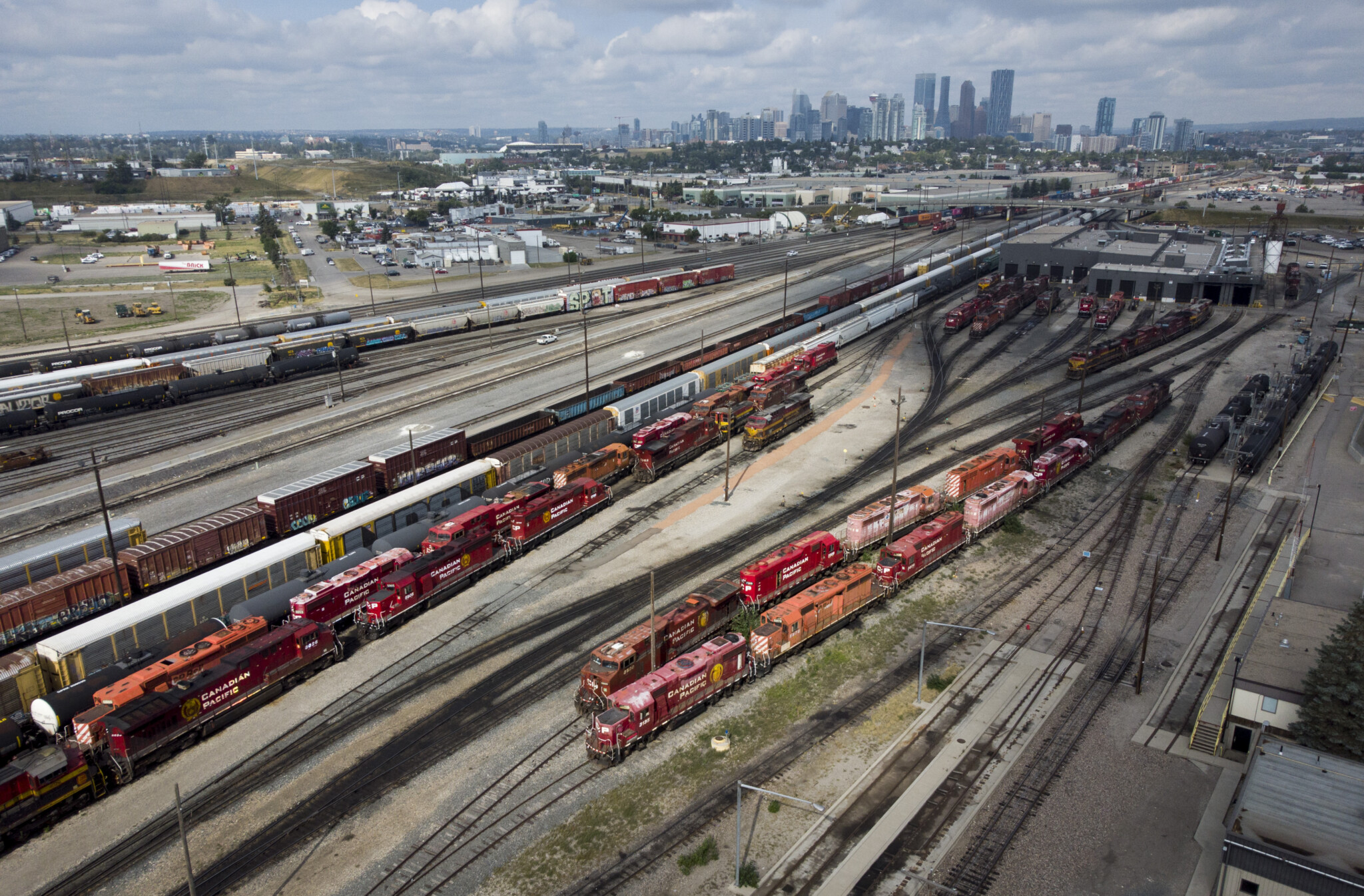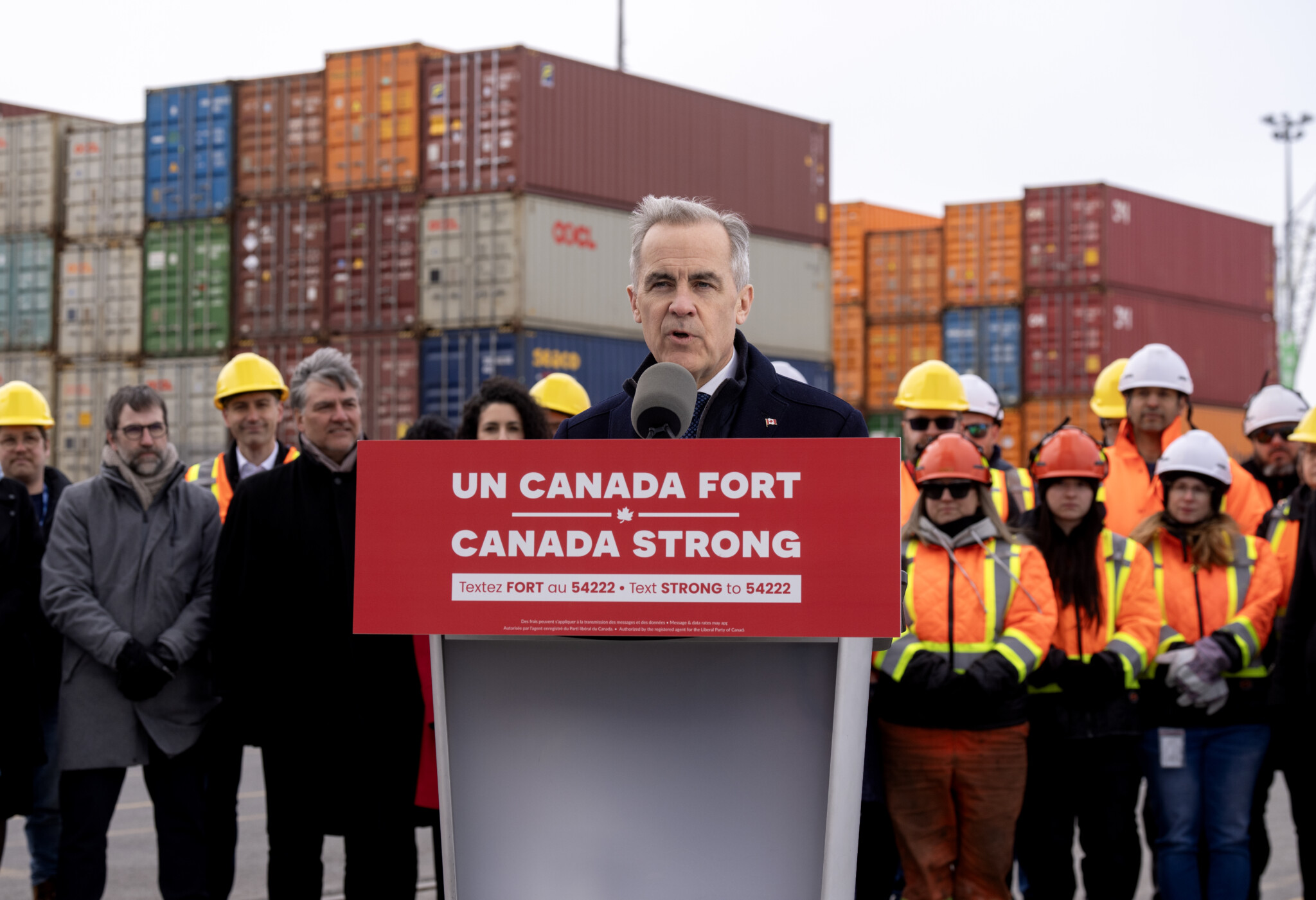DeepDives is a bi-weekly essay series exploring key issues related to the economy. The goal of the series is to provide Hub readers with original analysis of the economic trends and ideas that are shaping this high-stakes moment for Canadian productivity, prosperity, and economic well-being. The series features the writing of leading academics, area experts, and policy practitioners. The DeepDives series is made possible thanks to the ongoing support of the Centre for Civic Engagement.
With President Trump’s latest 35 percent tariff threat, there is no doubt that any deal with the U.S. is only a temporary deal. The only certainty with Trump is uncertainty; nothing can be taken for granted, and Canada’s economy can no longer depend on friendly, rules-based U.S. trade. Whether Prime Minister Carney reaches a deal or not in the coming months, as a trading nation rich in resources, Canada must invest rapidly to expand east-west infrastructure to diversify our trade to the rest of the world. In the federal budget this fall, one of the prime minister’s most important measures will be to demonstrate his commitment to this end.
To be sure, the ambition and scale of investment required will be enormous. Billions will need to be invested in more pipelines, roadways, rail lines, ports, and airports. The TMX expansion project is one clear example of the benefits of Canadian trade diversification, but that project alone cost $30 billion—it is not a scalable solution. The federal government alone with its balance sheet cannot be the sole investor in Canadian trade infrastructure. Prime Minister Carney must somehow manufacture billions in infrastructure investments while also not breaking the bank.
To meet the economic moment and the ambition expressed by Canadians in the last election, it is proposed that the prime minister consider and announce a $100 billion Canada Trade Diversification Plan, a Canadian “Marshall Plan” scale transformation of Canada’s economy. One that demonstrates the magnitude of his ambition but also makes hard decisions on political trade-offs and fiscal prudence.
The proposal has two parts:
- Part one: A transformation of focus for the Canada Infrastructure Bank, the Canada Growth Fund, the Business Development Bank of Canada (BDC), and Export Development Canada (EDC); and
- Part two: A transformation to bring in Canadian pension funds and institutional investors to leverage billions in new capex investment in Canada’s trade infrastructure: airports, ports, roads, rail, pipelines, and waterways.
Part one: A transformation of focus for federal government tools on trade diversification
In light of President Trump’s tariff aggression against Canada, the prime minister has pledged to accelerate large, transformational investments to diversify Canada’s economy, in particular for hard-hit sectors such as steel, aluminum, forest products, manufactured goods (auto), and agriculture.
The government has already taken several steps, including Bill C-5, the One Canadian Economy Act, and working with provinces to reduce interprovincial trade barriers. In the government’s upcoming fall budget, it is proposed that Canada announce a $100 billion plan reallocating and refocusing several of the federal government’s tools. These changes would be disruptive and challenging for many, but the rationale would be that hundreds of thousands of Canadian jobs are at risk, this is a defining moment in Canada’s economy, and Canada must be ambitious to meet the challenge.
Specifically, it is proposed that the government:
1. Refocus the Canada Infrastructure Bank (CIB) to laser its portfolio to trade diversification infrastructure: airports, ports, roads, rail, pipelines, and waterways. The CIB currently has a broad mandate, largely providing concessional debt for infrastructure projects in a number of different sectors, including public transit, energy, and broadband. The CIB has approximately $25 billion remaining in its allocated funding envelopes that could be fully reallocated to just Canadian trade infrastructure. The federal government could also increase the CIB’s available funding envelope by an additional $10 billion (cash, invested on a returns basis), which would not impact the federal fiscal deficit, and increase the total allocation to $35 billion. The CIB has played an important role in providing lower-cost capital to make on-the-bubble public-interest infrastructure projects real and investible. The CIB could also be directed to take on a greater risk-sharing role to support the development of earlier-stage projects.
2. Drive a new mandate for the Canada Growth Fund (CGF), including trade diversification infrastructure: The CGF, an idea created by the new clerk of the Privy Council, Michael Sabia, currently has a mandate to undertake equity investments in higher-risk green infrastructure, including carbon capture and storage, and critical raw minerals development. Both of these activities will be essential to Canada’s natural resources competitiveness, exports, and as part of Canada’s new 5 percent of GDP national defense funding commitment. The CGF has taken in-depth private sector experience, combined it with public policy goals, and has been catalytic in launching new, innovative equity investments in critical raw minerals and climate-related infrastructure projects, and this knowledge could be applied in an expanded mandate including trade diversification. The CGF has approximately $10 billion remaining in its allocated funding envelope that could be rebalanced to include Canadian trade infrastructure. The federal government could also increase its available funding by an additional $10 billion (cash, invested on a returns basis), which would not impact the federal fiscal deficit;

Export Development Canada (EDC) signage in Ottawa on Wednesday Sept. 7, 2022. Sean Kilpatrick/The Canadian Press.
3. Refocus BDC to reorient its lending activities to support Canadian small and medium-sized businesses affected by the tariffs, i.e., a Canadian business reinvestment plan from BDC to support businesses find new, non-U.S. markets for their goods and services. BDC issued $12 billion in loans last year. The budget can announce the re-orientation of $20 billion in loans ($5 billion annually) to this new purpose over four years;
4. Refocus EDC to reorient its lending activities to help Canadian businesses exporting to the United States find new markets. EDC currently has $32 billion in Government of Canada-backed export loans, insurance, and guarantees for businesses exporting to the U.S., and the Government of Canada can reasonably seek to rebalance this risk. The budget can provide a directive for EDC to reorient all or part of its U.S.-targeted portfolio of loans, insurance, and guarantees to other markets; and
5. The federal government has a $50 billion grant-based Canada Infrastructure Plan that focuses on public transit, rural communities, green infrastructure, and trade infrastructure ($10 billion out of the total). The budget could also announce an additional $10 billion in grant-based funding for trade infrastructure from the federal government, consistent with the government’s electoral platform commitment. This funding would affect the federal government’s fiscal framework/deficit. This funding could also be targeted to pure public policy projects, such as transportation roads, bridges, or overpasses leading in and out of ports and airports, or funding could be used to provide further firstloss capital for a portfolio of higher-risk investment projects beyond the risk profile of the CIB and CGF.
The above five items could sum to a $100 billion plan, reallocating and refocusing a large section of federal government business sector support tools with a reasonable impact on the federal budget. In making such an announcement, however, there will be a political values trade-off. In reorienting the CIB, CGF, BDC, and EDC, the government will be sending a message that it will be de-prioritizing other areas, public transit and climate change in particular. This is the risk-reward trade-off in any such budget commitment, but given the moment and many thousands of Canadian jobs at risk, it is an idea worth considering—something big, something that demonstrates the hard choices the government is willing to make.

A shipping container is loaded onto a ship in the Port of Montreal, Tuesday, Sept.19, 2023. Christinne Muschi/The Canadian Press.
Part two: A transformation to attract Canadian institutional investors and leverage billions in new capex in Canada’s trade infrastructure
Facilitative of part one, to achieve its investment goals, Canada will need to unleash private capital to expand Canada’s trade infrastructure.
As many know, Canada’s pension funds and the Canadian financial sector have considerable experience in owning, operating, and expanding trade infrastructure assets around the world. Canadian pension funds have owned and operated airports in Heathrow, Bristol, Birmingham, London City, Aberdeen, Glasgow, Brussels, Paris, Athens, San Juan, and Hamburg. Across the Canada Pension Plan Investment Board (CPPIB), the Public Sector Pension Investment Board (PSP), Caisse de dépôt et placement du Québec (CDPQ), and Ontario Teachers, their portfolios also include ownership of over 30 ports across the U.S. and 25 ports across England, Scotland, and Wales. Countries around the world have modernized and welcomed private sector investment in energy, rail, airports, ports, and border posts, including separating operators from infrastructure developers (e.g., power producers from distribution and transmission providers) to create markets and ensure competition.
Unfortunately, in much of Canada’s energy, rail, airport, and port sectors, there remains a protected system of monopolistic, direct or indirect quasi-governmental organizations. The federal government effectively owns Canada’s major airports and ports, and this ownership imposes heavy regulation on borrowing limits, constraints on public-private partnerships, and restrictions on the kinds of investments they can make. A National Bureau of Economic Research (2022) analysis of 2,444 airports across 217 countries found that well-regulated private investment in airports materially improved customer experience, the number of airline carriers (including low-cost carriers), the number of domestic and international routes, increased operating efficiency, and reduced flight cancellations by 50 percent. While the evidence of private port operations’ efficiency is mixed, what is clear is that countries around the world are cash-strapped and increasingly looking to leverage the private sector to fund airport and port infrastructure expansions.
The key is strong and balanced regulation that balances public policy objectives while still leveraging private sector dollars to fund expansions and modernizations—dollars that governments just don’t have. To this end, the Canadian Airports Council and the Association of Canadian Port Authorities have both advocated for greater flexibility to access and partner with pension funds and other investors to accelerate expansion plans, including building out greater airport cargo infrastructure, new port facilities, inter-modal transport corridors, and supply-chain sorting facilities.
In the rail sector, Canada is dominated by a few monopolistic rail companies, and there has long been a debate on open access, extended inter-switching, and investments in short-line rail lines to increase competition. There is no question that to increase trade east-west, both producers of goods and transportation providers that invest in trade route infrastructure must be profitable. But it does Canadian exporters little good if rail bottlenecks constrain the expansion of national ports. The key question now is what policy framework optimizes competition and an expansion of connective infrastructure to ports, airports, and waterways, maximizing export growth.
In the energy sector, federal and provincial barriers have stood in the way of the development of east-west energy pipelines and electricity transmission. Much of Canada’s electricity infrastructure remains owned and operated by state-owned entities more interested in their domestic markets and trading north-south. Canada’s new dynamic with the U.S. now raises serious questions on the wisdom of the historic “leave it to the provinces” approach or whether a greater national interest is required, as the prime minister has already indicated through Bill C-5.

Railcars and locomotives are shown at the CPKC railyard in Calgary, Thursday, Aug. 22, 2024. Jeff McIntosh/The Canadian Press.
Through government ownership or regulatory barriers, Canada has severely limited the opportunities for private sector investment in Canadian trade infrastructure—and to leverage the billions required, Canada cannot continue to maintain the status quo. Truthfully, adding greater capital to the CIB and CGF in part one will only contribute moderately if Canada continues to limit opportunities to invest in Canadian trade infrastructure.
Canada’s federal transportation infrastructure assets (airports, ports, waterways) have significant value in the private sector. Canada’s 17 federally owned airports have been conservatively estimated at over $17 billion; Canada’s nine federal ports including the Vancouver-Fraser Port Authority, the Prince Rupert Port Authority and the Halifax Port Authority sum to just over $6 billion in total enterprise value on the federal government balance sheet; as well as several pilotage (waterway transportation) assets. Each of these assets could be greatly expanded under new, experienced Canadian institutional investor ownership, owners with experience undertaking such investments around the world.
Politically, the transfer of ownership of such assets has faced significant push-back, but this concern has been receding with some more positive recent public opinion regarding Canadian airports. Such concerns can also be mitigated under a strong but fair regulatory framework, including inflation-adjusted regulated asset base (RAB) models with clear limits on noise, pollution, and service fee increases for consumers, all while providing regulatory certainty to investors on returns on invested capital, incentivizing them to invest in expansions, growing traffic, and throughput. RAB models could be explored in full or partial ownership models for new “expansion concessions” in exchange for multi-billion-dollar investment commitments from Canadian pension funds.
Key takeaways
Given the significance of the economic challenge and the imperative to galvanize billions in investment in Canada’s economy, the moment seems ripe to question Canada’s long-held tenets on government ownership and regulation. In addition to the $100 billion Canada Trade Diversification Plan, the upcoming budget could take big steps forward by:
- Announcing new funds to accelerate projects through its new national projects review process;
- Announcing a review of potential barriers to competition and investment in the expansion of rail infrastructure; and
- Announcing the government’s intent to accelerate an ownership reform in order to unleash private sector investment in Canadian airport, port, and waterway expansions, within regulated limits. If done in conjunction with part one, simultaneously increasing access to concessional financing from the CIB and CGF, this would send a strong signal to Canadian private sector investors that Canada is open for business, incenting them to accelerate investment and consequently Canadian economic growth.
In the last election, Canadians swung their vote on a belief that Carney better understood Canada’s economic moment. Canadians understand that our economy is under threat by its greatest ally; they will be willing to make sacrifices, and that painful but decisive actions will need to be taken. If Canada wants to shift the titanic and truly reorient our economy to the rest of the world, Canada’s government must commit and focus fully on this cause with all its available tools. Now is not the time for small and half-measures.









